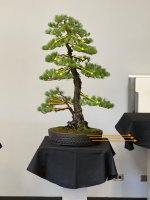iant
Chumono
Hi Dave,
Great looking tree!
Question. The branches on the daughter trunk are not as downsloping as the main trunk. Is that on purpose? The reason I ask is that I was confused when I first looked at the images if it was a branch or another trunk. Of course when I looked closer I could tell it was a 2nd trunk. Are you not following the angles of the main trunk with the branches of the daughter trunk because it's younger? or is there no rush in adjusting them? Also, there looks to be a few branches exiting the same position at the 2nd whorl on the daughter. I assume you're watching there and will ultimately remove one or two of those?
I don't mean to be annoying, just curious.
I killed my 1st JWP and haven't tried again so I can't say too much!
Best,
Ian
Great looking tree!
Question. The branches on the daughter trunk are not as downsloping as the main trunk. Is that on purpose? The reason I ask is that I was confused when I first looked at the images if it was a branch or another trunk. Of course when I looked closer I could tell it was a 2nd trunk. Are you not following the angles of the main trunk with the branches of the daughter trunk because it's younger? or is there no rush in adjusting them? Also, there looks to be a few branches exiting the same position at the 2nd whorl on the daughter. I assume you're watching there and will ultimately remove one or two of those?
I don't mean to be annoying, just curious.
I killed my 1st JWP and haven't tried again so I can't say too much!
Best,
Ian


